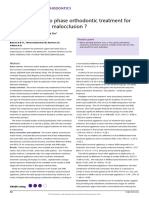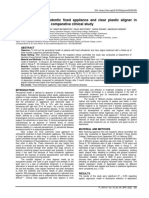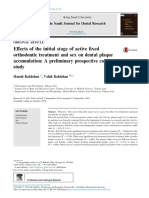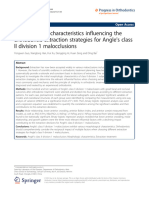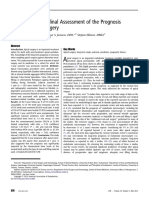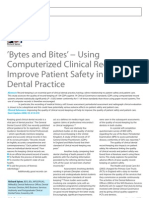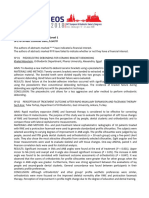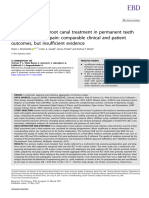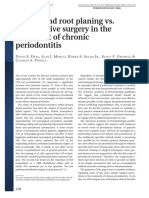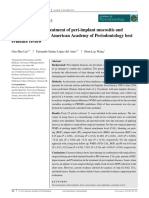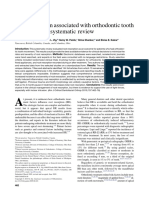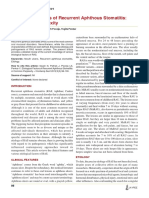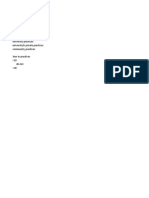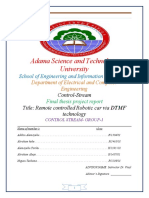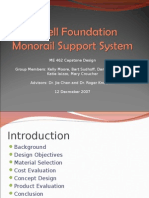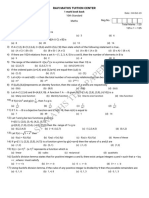Effectiveness of Phase I Orthodontic Treatment in An Undergraduate Teaching Clinic
Effectiveness of Phase I Orthodontic Treatment in An Undergraduate Teaching Clinic
Uploaded by
Rebin AliCopyright:
Available Formats
Effectiveness of Phase I Orthodontic Treatment in An Undergraduate Teaching Clinic
Effectiveness of Phase I Orthodontic Treatment in An Undergraduate Teaching Clinic
Uploaded by
Rebin AliOriginal Title
Copyright
Available Formats
Share this document
Did you find this document useful?
Is this content inappropriate?
Copyright:
Available Formats
Effectiveness of Phase I Orthodontic Treatment in An Undergraduate Teaching Clinic
Effectiveness of Phase I Orthodontic Treatment in An Undergraduate Teaching Clinic
Uploaded by
Rebin AliCopyright:
Available Formats
Effectiveness of Phase I Orthodontic
Treatment in an Undergraduate
Teaching Clinic
Andrew J. Bernas, D.D.S.; David W. Banting, D.D.S., Ph.D.;
Lesley L. Short, B.D.Sc., M.D.S., M.D.Sc.
Abstract: In this retrospective study, the Peer Assessment Rating (PAR) index was used to objectively evaluate the effectiveness
of Phase I (early) orthodontic treatment provided in an undergraduate teaching clinic. Pre-treatment and post-treatment casts of
ninety-three patients were analyzed. All patients selected for Phase I orthodontic treatment had Class I skeletal relationships and
did not require complex orthodontic treatment such as growth modification or treatment of occlusions with missing or impacted
teeth. The mean age of patients who received Phase I orthodontic treatment was 9.9 years. The mean initial PAR score for the
sample was 29.70 ±9.84. The mean reduction in PAR score was 14.9 points corresponding to a 50.2 percent decrease in the PAR
score following Phase I orthodontic treatment. Seventy-three percent of the patients experienced at least a 30 percent reduction in
their PAR score following Phase I (early) orthodontic treatment. The mean cost of $381.00 for the Phase I orthodontic treatment
was found to be influenced by the length of treatment, type of Phase I treatment provided, age at start of treatment, and percentage
reduction in PAR score. The greatest success rate for the Phase I orthodontic treatment occurred with either fixed or a combina-
tion of fixed and removable appliances. Over half of the patients recommended for Phase I orthodontic treatment in the under-
graduate dental clinic were successfully treated and did not require Phase II treatment. For them, there was both a treatment and
a financial benefit to the Phase I orthodontic treatment.
Dr. Bernas was a Doctor of Dental Surgery Candidate; Dr. Banting is Chair, Division of Practice Administration; and Dr. Short
is Clinical Director, Graduate Orthodontics—all at the Schulich School of Medicine & Dentistry, University of Western Ontario,
London, Ontario, Canada. Direct correspondence and requests for reprints to Dr. Lesley Short, Schulich School of Medicine
& Dentistry, Graduate Orthodontics, 1151 Richmond Street, London, Ontario N6A 5C1, Canada; 519-661-3358, ext. 86118;
519-661-3875 fax; lesley.short@schulich.uwo.ca.
Key words: orthodontics, undergraduate education, treatment outcome, PAR
Submitted for publication 2/7/07; accepted 4/12/07
O
ver the past few decades, the dental com- index is measured both as a reduction in the total
munity has become increasingly interested in score and as a percentage reduction. Richmond et
the objective analysis of treatment outcomes al.12 found that a change (reduction) greater than 30
in order to assess quality of care.1 Traditionally, percent in the weighted PAR score is required for a
orthodontic diagnosis has been considered resistant case to be considered as improved, and a reduction
to quantitative evaluation because of its subjective of at least twenty-two points is deemed to be a great
nature.2-4 The development of quantitative systems improvement. Other studies have reported that a
for assessing malocclusion and evaluating treatment change in PAR score greater or equal to 70 percent
need have been evolving for the last half of the past can be categorized as great improvement.13,14
century.5 These indices aim to provide valid systems The PAR index has become increasingly used
of measurement that are easily reproducible.6-9 in studies assessing the effectiveness of orthodontic
One such index, the Peer Assessment Rating treatment in private practices and graduate clin-
(PAR), was developed in 1990 by Richmond.10 It ics.4,14-23 A study by Birkeland et al.17 involving 224
quantifies malocclusion based on five criteria of dif- cases treated in a postgraduate clinic achieved a
ferent weightings: upper and lower anterior segment mean reduction in PAR score of 76.7 percent. These
alignment (x1), left and right buccal occlusion (x1), results were comparable to a study performed by
overjet (x6), overbite (x2), and centerline (x4). The Willems et al.16 that involved 292 cases and a study
analysis is performed on dental casts and involves a by Buchanan et al.24 that involved eighty-two cases
comparison between pre-treatment and post-treat- with mean reductions of 79.1 percent and 74 percent,
ment study models permitting the evaluation of respectively. A study by Fox25 obtained a 66 percent
treatment effectiveness in aligning teeth within and reduction using removable, fixed, and functional
between the dental arches.7,11 A change in the PAR appliances.
September 2007 ■ Journal of Dental Education 1179
Results of orthodontic treatment outcomes instructor from China, and a full-time orthodontic
in undergraduate clinics are also available. Tolidis faculty member. Replicate measurements were per-
and Sandy15 performed a study of the effectiveness formed by all evaluators on twenty randomly selected
of orthodontic treatment over two time periods and cases to determine measurement error. The error
published PAR score reductions of 64 percent and among the three evaluators was within one point on
47 percent. In terms of Phase I or early intervention, the PAR index.
Pangrazio-Kulbersh et al.14 reported a 38 percent Information obtained for each patient included
decrease in PAR scores. the patient’s age at start of treatment, patient’s gender,
The objective of this study was to measure, by type of malocclusion, type of treatment provided,
means of the PAR index, the effectiveness of Phase need for additional orthodontic (Phase II) treatment
I orthodontic treatment performed in an undergradu- (due to relapse, incompletion of treatment, or referral
ate dental school clinic. The study also assessed the to private practice or graduate orthodontics), treat-
ability of Phase I treatment to alleviate or prevent the ment fees charged, and number of treatment episodes
need for Phase II therapy (i.e., full fixed appliance (some patients had more than one episode of Phase
comprehensive treatment) and the cost-effectiveness I treatment).
of Phase I treatment. The cost of the Phase I orthodontic treatment
was calculated in order to assess the cost-effective-
ness of the treatment. Fees were charged for diagnos-
Methods tic casts, cephalometric and panoramic radiographs,
extractions (if orthodontically related), appliances,
Cases were selected from the archives of the un- laboratory costs, and appliance adjustments. These
dergraduate Simulated Practice Environment Clinic fees reflect only the cost of the Phase I orthodontic
(SPEC), Schulich Dentistry, University of Western treatment and not the cost of all treatment provided
Ontario. The study models of 342 randomly selected to the patient in the undergraduate clinic.
patients who had received Phase I (early) orthodontic Analysis of the data was performed using de-
treatment were examined. Two hundred and forty- scriptive statistics and multiple variable regression
nine patients were excluded from the study based on models in the JMP v. statistical program. Reductions
the following reasons: there were incomplete records, in PAR scores between pre-treatment and post-treat-
the patient went directly into Phase II orthodontic ment study models were calculated both as a percent-
treatment, or the patient was too old at the start of age and as a whole number. P-values less than 0.05
treatment (over fourteen years for females and sixteen were considered to be statistically significant.
years for males). Based on these exclusion factors,
ninety-three cases were analyzed in the study.
Pre-treatment and post-treatment study mod-
els were evaluated, using the PAR index, by an
Results
undergraduate dental student, a visiting orthodontic Of the ninety-three cases selected, there were
fifty-six (60.2 percent) female patients and thirty-
seven (39.8 percent) male patients. The mean age was
Table 1. Number and percent of orthodontic problems 121.23 months (10.10 years) for female patients and
in ninety-three patients undergoing Phase I treatment 114.70 months (9.56 years) for male patients.
Orthodontic Problem N (%)
The types of orthodontic problems present in
the ninety-three patients are shown in Table 1. All
Anterior cross bite 29 (31.3%) of the cases at pre-treatment were Class I in terms
Posterior cross bite 29 (31.2%) of their skeletal relationship, although a few cases
Arch length to tooth size discrepancy 64 (68.8%)
• Crowding 44 (47.3%) were Class II or Class III with respect to their dental
• Spacing (including midline diastema) 24 (25.8%) relationship.
Vertical discrepanciesa 17 (18.3%) The majority of patients in this study (68.8
Otherb 18 (19.4%) percent) had an arch length to tooth size discrepancy.
Total 157*
The most common treatment modality provided was
a
Deep bite and open bite partial fixed appliances (41 percent). The distribution
b
Habit correction and midline deviations of treatment modalities used during Phase I treatment
*Some patients had more than one problem.
is presented in Figure 1.
1180 Journal of Dental Education ■ Volume 71, Number 9
Figure 1. Percent of Phase I orthodontic treatment provided by treatment type
a
Expansion appliances include both slow palatal expansion (removable) and rapid palatal expansion (fixed) appliances.
b
Active removable appliances not involving expansion.
The mean pre-treatment PAR score was 29.71 score reduction is accounted for by the length of
±9.84, and that score dropped to a mean of 14.80 the Phase I treatment (Figure 3). The mean percent
±9.46 following Phase I treatment. This represents reduction in PAR scores by type of treatment used
an average 50.2 percent reduction in the PAR score. in the Phase I treatment ranged from 41.6 percent to
The mean length of treatment was 16.30 ±11.78 51.8 percent. There was no statistically significant
months with a range of three to fifty-nine months, and difference found among the mean percent reduction
the mean cost of the Phase I treatment was $380.79 in PAR scores attributed to the different types of
±$186.66 with a range of $65.00 to $1,131.50. Phase I treatment provided (p=0.92).
Seventy-five percent of the patients underwent A multiple regression model revealed that the
a single episode of Phase I treatment, while the post-treatment PAR score was significantly influ-
remainder (25 percent) had two or more episodes enced by the pre-treatment PAR score (p=0.002)
(three patients had three episodes of Phase I treat- and the length of the treatment (p=0.02). But there
ment). Based on the nomogram in Figure 2, a reduc- was also a significant interaction term between the
tion (improvement) in PAR score ≥30 percent was pre-treatment PAR score and the length of the Phase
shown in sixty-eight cases (73.1 percent). Twenty-six I treatment (p=0.01), indicating that the effect of the
patients (28.0 percent) had a reduction in their PAR pre-treatment PAR score and the length of treatment
scores ≥70 percent, qualifying them as being greatly on the post-treatment PAR score must be interpreted
improved following Phase I treatment. Twenty-five with caution. The type of treatment, multiple treat-
patients (26.9 percent) either showed no difference or ment episodes, and age at start of treatment were
a deterioration in their PAR scores. Additional (Phase not significant predictors of the post-treatment PAR
II) treatment was recommended for 47.3 percent of score.
the patients (Table 2). Both III Year (junior) and IV Similarly, a multiple variable regression model
Year (senior) students provided the Phase I treatment showed that the length of treatment (p=0.003), the
under supervision. age at start of treatment (p=0.04), the treatment
A positive but low (r=0.24, R2=0.06) correla- type (p=0.007), and the percent PAR score change
tion was found between the percent reduction in the (p=0.006) were all statistically significant variables
PAR score and the length of the treatment. Longer for predicting the cost of treatment. Gender and
treatment resulted in slightly greater PAR score the pre-treatment PAR score were not statistically
reductions; however, very little of the percent PAR significant explanatory variables for predicting cost
September 2007 ■ Journal of Dental Education 1181
Figure 2. Nomogram illustrating pre-treatment and post-treatment PAR scores in terms of degree of improvement
Table 2. Number and percent of patients recommended for Phase II treatment following Phase I treatment by type of
Phase I treatment
Type of Phase I Treatment Provided Number of Patients Number and Percent of Patients
Completing Phase I Treatment Recommended for Phase II Treatment
Expansiona 17 12 (70.6%)
Expansiona and fixed 9 6 (66.7%)
Fixed only 38 12 (31.6%)
Removable only 18 10 (55.6%)
Removableb and fixed 11 4 (36.4%)
Overall 93 44 (47.3%)
a
Expansion appliances include both slow palatal expansion (removable) and rapid palatal expansion (fixed) appliances.
b
Active removable appliances not involving expansion.
of treatment. No interaction terms were used. This
model was able to account for 35.2 percent of the Discussion
variability in the cost of Phase I treatment.
Phase I (early) orthodontic treatment is advo-
The mean fees for the various Phase I treat-
cated for several types of orofacial problems ranging
ment modalities of treatment are presented in Table
from simple space management to more complicated
3. Treatment involving partial fixed appliances was
problems requiring skeletal and dental changes.
the most expensive, especially when combined with
In this study, only Phase I orthodontic treatment
other treatment types. The total fee charged for the
provided in a dental school undergraduate clinic
Phase I treatment was shown to correlate positively
was investigated. This study did not look at Phase I
(r=0.36, R2=0.13) with the percent reduction in PAR
treatment associated with skeletal malocclusions or
score (Figure 4).
complicated dental malocclusions.
1182 Journal of Dental Education ■ Volume 71, Number 9
Figure 3. Percent change (reduction) in PAR score by length of treatment (r=0.24, R2=0.06)
Over half (53 percent) of the sample did not these considerations, complete reduction of PAR is
continue on to Phase II treatment because an adequate not expected in Phase I. Another explanation for these
outcome was achieved with Phase I treatment. This results is that the cases selected in the undergraduate
finding is encouraging as it is rare for a malocclusion clinic are uncomplicated. Patients treated are skeletal
to improve without orthodontic intervention.14,26,27 It Class I with only mild to moderate malocclusions.
should be remembered that Phase I treatment is con- Thus, another explanation for the limited reduction
siderably less expensive than Phase II treatment. in PAR for this group could be the low initial PAR
The mean percentage change (reduction) in scores, thereby making it more difficult to achieve a
PAR score in this study was lower than
studies assessing Phase II or compre-
hensive treatment.1,4,17,24,28 However, this
study agreed with a study by Pangrazio- Table 3. Mean cost of Phase I treatment by type of treatment
Kulbersh et al. that assessed Phase I Type of Phase I Treatment Mean Cost Standard Deviation
treatment.14 This suggests that the degree
Expansiona and fixed $503.72 204.39
of improvement in PAR score is reflec- Removableb and fixed $485.32 195.09
tive of the phase of treatment assessed. Expansiona only $307.29 150.02
Phase I (early or limited treatment) is Fixed only $386.49 192.23
not necessarily designed to finish the Removableb only $312.83 139.54
Overall $380.79
occlusion but to address major concerns
of the malocclusion that are noted early, a
Expansion appliances include both slow palatal expansion (removable) and
thereby alleviating the need for compre- rapid palatal expansion (fixed) appliances.
b
Active removable appliances not involving expansion.
hensive orthodontic treatment. Given
September 2007 ■ Journal of Dental Education 1183
Figure 4. Percent change (reduction) in PAR score by cost of treatment (r=0.36, R2=0.13)
more substantial percent reduction in the PAR score treated with removable appliances initially were
as noted by other authors.5,14,24 recommended to continue with either further Phase I
The sample (n=93) was comprised of 60 or Phase II treatment. Therefore, based on the results
percent females and 40 percent males. This gender of this study, removable appliances are not gener-
distribution is similar to that reported in other stud- ally able to completely address Phase I orthodontic
ies.15,29,30 The age at the start of treatment (mean 9.9 treatment needs. Apart from mechanical inefficiency,
years) indicates that, generally, skeletal growth is still other possible explanations for this finding are poor
occurring in these patients.14,24,25,31 patient compliance and appliance failure. These fea-
Since there was a positive association between tures are more common with removable appliances
the cost of Phase I orthodontic treatment and both than with fixed appliances. Fixed appliances are gen-
the percentage change in PAR scores and the amount erally more efficient because compliance and failure
of reduction in PAR scores, it would appear that the are more easily managed, which appears to translate
more money that is spent, the better the result that can into less need for additional episodes of treatment.
be expected. However, the model used to predict the In comparison, only about 30 percent of patients who
cost of Phase I orthodontic treatment was only able received partial fixed appliances initially in Phase I
to account for or explain a small proportion of the treatment required further Phase I or Phase II cor-
variability in the fees charged. Thus, there are likely rection. Our study also showed that when expansion
other parameters that were not included in this study is included in Phase I treatment, the need for further
that may influence the overall fee to the patient (e.g., treatment (either Phase I or II) is high (70 percent).
diagnostic skills of the clinician). This may reflect the increased difficulty of manage-
While removable appliances were shown to be ment of lateral deficiencies.
less expensive than the other treatment modalities, There is a lack of consensus among orthodon-
nearly 40 percent of patients who received removable tists as to different treatment modalities during Phase
appliances had to combine their treatment with partial I treatment.14 This study did not show any differences
fixed appliances because the removable appliance between treatment modalities in terms of PAR score
alone was unable to complete the Phase I treatment. reduction. This finding has been demonstrated pre-
Furthermore, approximately 56 percent of patients viously14 and may reflect the ability of orthodontists
1184 Journal of Dental Education ■ Volume 71, Number 9
to arrive at a similar result using different methods. • the proper selection of cases for Phase I orth-
Further studies analyzing the way different treatment odontic treatment is critical to the success of the
modalities influence the different components of the treatment.
PAR score may reveal whether one treatment mode
is more efficient at correcting a specific malocclu- Acknowledgments
sion, even though the overall change in PAR may We would sincerely like to thank Dr. Sara
be similar. There is also a lack of consensus among Shamloo for her expertise in the application of PAR
orthodontists regarding the need for Phase I treatment score analysis, Dr. Fernando Inocencio for the use of
at all.32,33 If Phase I treatment is sufficient to correct a computer, Dr. Lihua Shan for her assistance with
the malocclusion, it can be financially beneficial. data collection, and Dr. Sahza Hatibovic-Kofman
This study showed that over half the cases treated in and the secretarial staffs of Graduate Orthodontics,
this undergraduate clinic enjoyed this benefit. How- SPEC, and Main Clinic for all their assistance and
ever, nearly half of the cases in this study required support during this project.
Phase II treatment, raising the possibility that Phase
II (comprehensive treatment) alone may have been
able to address all treatment needs in a single episode
REFERENCES
without the additional fees for Phase I treatment.
1. Al Yami EA, Kuijpers-Jagtman AM, van’t Hof MA. Oc-
Despite the fact that the Simulated Practice clusal outcome of orthodontic treatment. Angle Orthod
Environment Clinic is part of a teaching institution 1998;68(5):439-44.
and that much of the treatment provided represents 2. Firestone AR, Beck FM, Beglin FM, Vig KW. Evaluation
valuable teaching material, it is apparent that the ex- of the peer assessment rating (PAR) index as an index of
pectation for success for early (Phase I) orthodontic orthodontic treatment need. Am J Orthod Dentofacial
Orthop 2002;122(5):463-9.
treatment may be overly optimistic and that either 3. McGorray SP, Wheeler TT, Keeling SD, Yurkiewicz L,
more exact diagnostic tools or more rigidly applied Taylor MG, King GJ. Evaluation of orthodontists’ per-
criteria are needed to ensure a successful outcome. ception of treatment need and the peer assessment rating
These results underscore the need to emphasize the (PAR) index. Angle Orthod 1999;69(4):325-33.
importance of diagnostic skills and pre-treatment 4. Dyken RA, Sadowsky PL, Hurst D. Orthodontic outcomes
assessment using the peer assessment rating index. Angle
assessment in the undergraduate orthodontic cur- Orthod 2001;71(3):164-9.
riculum and treatment clinics. 5. Kamatovic M. A retrospective evaluation of the effective-
ness of Invisalign appliance using the PAR and irregularity
indices [M.Sc. thesis]. Toronto: University of Toronto,
Conclusions 2004.
6. Weerakone S, Dhopatkar A. Clinical outcome monitoring
From the results of this study, it may be con- program (COMP): a new application for use in orthodontic
audits and research. Am J Orthod Dentofacial Orthop
cluded that
2003;123(5):503-10; discussion 10-11.
• a 30 percent or greater improvement (reduction) 7. Richmond S, Buchanan IB, Burden DJ, O’Brien KD, An-
in PAR scores was achieved in 73.1 percent of drews M, Roberts CT, et al. Calibration of dentists in the
the cases recommended for Phase I orthodontic use of occlusal indices. Community Dent Oral Epidemiol
treatment; 1995;23(3):173-6.
• over half (52.7 percent) of the patients undergoing 8. Bergstrom K, Halling A. Comparison of three indices
in evaluation of orthodontic treatment outcome. Acta
Phase I orthodontic treatment were successfully Odontol Scand 1997;55(1):36-43.
treated and did not require Phase II orthodontic 9. Shaw WC, Richmond S, O’Brien KD, Brook P, Stephens
treatment; CD. Quality control in orthodontics: indices of treatment
• there was no statistically significant difference in need and treatment standards. Br Dent J 1991;170(3):
the percent PAR score reduction produced as a re- 107-12.
10. Richmond S. A critical evaluation of orthodontic treat-
sult of the type of Phase I orthodontic treatment; ment in the general dental services of England and Wales
• generally, a greater improvement in PAR score [Ph.D. thesis]. Manchester, UK: University of Manches-
was associated with longer treatment periods and ter, 1990.
greater treatment costs; 11. Firestone AR, Hasler RU, Ingervall B. Treatment results
• the greatest success rate for the Phase I orthodontic in dental school orthodontic patients in 1983 and 1993.
Angle Orthod 1999;69(1):19-26.
treatment occurred with either fixed or a combina- 12. Richmond S, Shaw WC, O’Brien KD, Buchanan IB, Jones
tion of fixed and removable appliances; and R, Stephens CD, et al. The development of the PAR index
September 2007 ■ Journal of Dental Education 1185
(peer assessment rating): reliability and validity. Eur J 23. Mascarenhas AK, Vig K. Comparison of orthodontic
Orthod 1992;14(2):125-39. treatment outcomes in educational and private practice
13. Elderton RJ, Clark JD. Orthodontic treatment in the settings. J Dent Educ 2002;66(1):94-9.
General Dental Service assessed by the occlusal index. Br 24. Buchanan IB, Russell JI, Clark JD. Practical application of
J Orthod 1983;10(4):178-86. the PAR index: an illustrative comparison of the outcome
14. Pangrazio-Kulbersh V, Kaczynski R, Shunock M. Early of treatment using two fixed appliance techniques. Br J
treatment outcome assessed by the peer assessment rat- Orthod 1996;23(4):351-7.
ing index. Am J Orthod Dentofacial Orthop 1999;115(5): 25. Fox NA. The first 100 cases: a personal audit of orthodon-
544-50. tic treatment assessed by the PAR (peer assessment rating)
15. Tolidis K, Sandy JR. Standards of orthodontic treatment index. Br Dent J 1993;174(8):290-7.
in cases treated by undergraduate students at Bristol Den- 26. Salzmann JA. Orthodontics in practice and perspective.
tal Hospital from 1982 to 1992. Br Dent J 1994;177(6): Am J Orthod 1969;55(6):556-65.
203-7. 27. Al Yami EA, Kuijpers-Jagtman AM, van’t Hof MA. As-
16. Willems G, Heidbuchel R, Verdonck A, Carels C. Treat- sessment of biological changes in a nonorthodontic sample
ment and standard evaluation using the peer assessment using the PAR index. Am J Orthod Dentofacial Orthop
rating index. Clin Oral Investig 2001;5(1):57-62. 1998;114(2):224-8.
17. Birkeland K, Furevik J, Boe OE, Wisth PJ. Evaluation of 28. Fox NA, Richmond S, Wright JL, Daniels CP. Factors af-
treatment and post-treatment changes by the PAR index. fecting the outcome of orthodontic treatment within the
Eur J Orthod 1997;19(3):279-88. general dental service. Br J Orthod 1997;24(3):217-21.
18. Wijayaratne D, Harkness M, Herbison P. Functional appli- 29. Rose JS. A thousand consecutive treated orthodontic cases:
ance treatment assessed using the PAR index. Aust Orthod a survey. Br J Orthod 1974;1(2):45-54.
J 2000;16(3):118-26. 30. Banks PA, Corkill CM, Bowden DE, Morse PH, Shaw
19. Stephens CD. PAR index to assess the effectiveness of WC. The consultant orthodontic service: 1985 survey. Br
removable orthodontic appliance treatment [comment]. Dent J 1988;165(12):425-9.
Br J Orthod 1994;21(3):313. 31. Richmond S. Personal audit in orthodontics. Br J Orthod
20. Richmond S, Shaw WC, Roberts CT, Andrews M. The 1993;20(2):135-44.
PAR index (peer assessment rating): methods to determine 32. Dolce C, Schader RE, McGorray SP, Wheeler TT. Centro-
outcome of orthodontic treatment in terms of improvement graphic analysis of 1-phase versus 2-phase treatment for
and standards. Eur J Orthod 1992;14(3):180-7. Class II malocclusion. Am J Orthod Dentofacial Orthop
21. Poulton DR, Baumrind S, Vlaskalic V. Treatment outcomes 2005;128(2):195-200.
in 3 modes of orthodontic practice. Am J Orthod Dento- 33. Hayes JL. One-phase versus 2-phase treatment. Am J
facial Orthop 2002;121(2):176-84. Orthod Dentofacial Orthop 2005;128(5):557-8; author
22. Otuyemi OD. Evaluation of orthodontic treatment out- reply 558.
come: a personal clinical audit using the PAR index (peer
assessment rating). Afr Dent J 1995;9:1-8.
1186 Journal of Dental Education ■ Volume 71, Number 9
You might also like
- Materi-Minggu 12-TPP Ii-Kur 21Document12 pagesMateri-Minggu 12-TPP Ii-Kur 21toto nugrohoNo ratings yet
- Lec - 2 - Z, Double Z, T SpringDocument4 pagesLec - 2 - Z, Double Z, T SpringRebin Ali100% (1)
- Geometrodynamics of Gauge Fields - On The Geometry of Yang-Mills and Gravitational Gauge Theories PDFDocument377 pagesGeometrodynamics of Gauge Fields - On The Geometry of Yang-Mills and Gravitational Gauge Theories PDFDennis Gerken100% (3)
- Assessment of The Removable Orthodontic Treatment Outcome Using Peer Assessment Rating IndexDocument7 pagesAssessment of The Removable Orthodontic Treatment Outcome Using Peer Assessment Rating IndexRosehill Dental PracticeNo ratings yet
- E V A L U A T I o N o F T H e O U T C o M e o F R e M o V A B L e O R T H o D o N T I C T R e A T M e N T P e R F o R M e D B y D e N T A L U N D e R G R A D U A T e S T U D e N T SDocument5 pagesE V A L U A T I o N o F T H e O U T C o M e o F R e M o V A B L e O R T H o D o N T I C T R e A T M e N T P e R F o R M e D B y D e N T A L U N D e R G R A D U A T e S T U D e N T SRebin AliNo ratings yet
- Online Only Abstracts - YmodDocument5 pagesOnline Only Abstracts - Ymodakshantz ekkaNo ratings yet
- Endodontic Surgery Prognostic Factors: Oral Cancer /restorativeDocument2 pagesEndodontic Surgery Prognostic Factors: Oral Cancer /restorativeYvelisse LoraNo ratings yet
- Ijodr 2 (4) 172-176Document5 pagesIjodr 2 (4) 172-176drzana78No ratings yet
- NG 2007Document19 pagesNG 2007NunoGonçalvesNo ratings yet
- Orthodontic Treatment Stability PredictorsDocument7 pagesOrthodontic Treatment Stability PredictorsMaria Fernanda Garcia PucheNo ratings yet
- Veitz-Keenan One - Phase - or - Two - Phase - OrthodoDocument3 pagesVeitz-Keenan One - Phase - or - Two - Phase - OrthodoJuliana ÁlvarezNo ratings yet
- Toronto Phase 3Document8 pagesToronto Phase 3Noemi ComanNo ratings yet
- Quantitative Analysis of Miller Mobility Index For The Diag 2018 Journal ofDocument5 pagesQuantitative Analysis of Miller Mobility Index For The Diag 2018 Journal ofAgung AdhaNo ratings yet
- Zeeshan Article in LMDC JournalDocument3 pagesZeeshan Article in LMDC JournalMuhammad zeeshanNo ratings yet
- Bushra VasimDocument5 pagesBushra VasimVinod ViswanathanNo ratings yet
- Effects of The Initial Stage of Active Fixed Orthodontic Treatment and Sex On Dental Plaque Accumulation: A Preliminary Prospective Cohort StudyDocument5 pagesEffects of The Initial Stage of Active Fixed Orthodontic Treatment and Sex On Dental Plaque Accumulation: A Preliminary Prospective Cohort StudyRebin AliNo ratings yet
- Orthodontic TreatmentDocument7 pagesOrthodontic Treatment119892020No ratings yet
- 2018 Ergonomic Evaluation of Dental Professionals As Determined by REBA Method in 2014Document4 pages2018 Ergonomic Evaluation of Dental Professionals As Determined by REBA Method in 2014AbelNo ratings yet
- J Ajodo 2018 07 018Document7 pagesJ Ajodo 2018 07 018Zaheer bashaNo ratings yet
- Sahrmann 2010Document12 pagesSahrmann 2010Dragos CiongaruNo ratings yet
- Int Endodontic J - 2022 - Shah - Outcomes Reporting in Systematic Reviews On Surgical Endodontics A Scoping Review For TheDocument22 pagesInt Endodontic J - 2022 - Shah - Outcomes Reporting in Systematic Reviews On Surgical Endodontics A Scoping Review For TheDhiaa AloweadatNo ratings yet
- OrtodonciaDocument14 pagesOrtodoncialibroscasitaNo ratings yet
- Lenzi 2016Document9 pagesLenzi 2016Jhovanny OrozcoNo ratings yet
- Coll, 2017Document13 pagesColl, 2017Estaf EmkeyzNo ratings yet
- Satisfaction With Orthodontic Treatment Outcome: Original ArticleDocument7 pagesSatisfaction With Orthodontic Treatment Outcome: Original ArticleVANESA REYESNo ratings yet
- Evaluation of Diagnostic Process in Oral Surgery Department: January 2015Document7 pagesEvaluation of Diagnostic Process in Oral Surgery Department: January 2015DivaNo ratings yet
- Patient's Expectation of Orthodontic Treatment at A Tertiary Health Facility in Lagos, NigeriaDocument6 pagesPatient's Expectation of Orthodontic Treatment at A Tertiary Health Facility in Lagos, NigeriadochetNo ratings yet
- Prosto 2 2Document9 pagesProsto 2 2tepokpantatNo ratings yet
- Ext CII-1Document7 pagesExt CII-1Miguel Walter Ramón NeyraNo ratings yet
- Vonarx 2012Document10 pagesVonarx 2012Laura A. Moraes PintoNo ratings yet
- The Effect of Micro-Osteoperforations On The Rate of Orthodontic Tooth MovementDocument15 pagesThe Effect of Micro-Osteoperforations On The Rate of Orthodontic Tooth MovementFouad El-SharabyNo ratings yet
- Record KeepingDocument5 pagesRecord KeepingainakasimNo ratings yet
- Liu 2017Document6 pagesLiu 2017CAROLINA GOMEZ GONZALEZNo ratings yet
- Scientific Posters (PDFDrive)Document233 pagesScientific Posters (PDFDrive)Asma R. El KawafiNo ratings yet
- Awareness of Infection Control Among Dental Students and Interns - PMCDocument9 pagesAwareness of Infection Control Among Dental Students and Interns - PMCmvergaraa11No ratings yet
- Leong 2019Document10 pagesLeong 2019David UriosteguiNo ratings yet
- Factors in Uencing Satisfaction With The Process of Orthodontic Treatment in Adult PatientsDocument9 pagesFactors in Uencing Satisfaction With The Process of Orthodontic Treatment in Adult PatientsLikhitaNo ratings yet
- Pulpotomy Versus Root Canal Treatment in Permanent Teeth With Spontaneous Pain: Comparable Clinical and Patient Outcomes, But Insuf Ficient EvidenceDocument3 pagesPulpotomy Versus Root Canal Treatment in Permanent Teeth With Spontaneous Pain: Comparable Clinical and Patient Outcomes, But Insuf Ficient EvidenceKhanh Vũ Phương LêNo ratings yet
- Oral Mucosal Ulceration During Orthodontic Treatment - The Perception of Patients and Knowledge and Attitude of The Orthodontic Practitioners - PMCDocument11 pagesOral Mucosal Ulceration During Orthodontic Treatment - The Perception of Patients and Knowledge and Attitude of The Orthodontic Practitioners - PMCNurhana NadhifahNo ratings yet
- Prosto FixDocument3 pagesProsto FixNiken Tri HapsariNo ratings yet
- Resultados Del Tratamiento Completo de Ortodoncia Con Aparatos FijosDocument29 pagesResultados Del Tratamiento Completo de Ortodoncia Con Aparatos FijosDavid NavarroNo ratings yet
- Treatment Outcome in Endodontics - The Toronto Study - Phases 3 and 4 - Orthograde RetreatmentDocument7 pagesTreatment Outcome in Endodontics - The Toronto Study - Phases 3 and 4 - Orthograde RetreatmentFrancisco liebbeNo ratings yet
- Choosing The Criteria For Clinical Evaluation of Composite RestorationsDocument8 pagesChoosing The Criteria For Clinical Evaluation of Composite Restorationsfloressam2000No ratings yet
- Anxiety About Dental Treatment - A Gender IssueDocument6 pagesAnxiety About Dental Treatment - A Gender Issueyeniescamilla191213No ratings yet
- Orthognathic Treatment and TemporomandibularDocument16 pagesOrthognathic Treatment and TemporomandibularNadeen AttariNo ratings yet
- Journal 5Document5 pagesJournal 5Nadya PurwantyNo ratings yet
- Scaling Teeth TechniquesDocument12 pagesScaling Teeth TechniqueshanyNo ratings yet
- Orthodontic Anchorage A Systematic ReviewDocument9 pagesOrthodontic Anchorage A Systematic ReviewIvanna H. A.No ratings yet
- Antoun 2015Document8 pagesAntoun 2015yina montoyaNo ratings yet
- The Relationship Between Index ofDocument5 pagesThe Relationship Between Index ofanisza.workNo ratings yet
- Scientific Posters v2Document217 pagesScientific Posters v2Cernei Eduard RaduNo ratings yet
- Global Doctor Opinion Versus A Patient Questionnaire For The Outcome Assessment of Treated Temporomandibular Disorder PatientsDocument3 pagesGlobal Doctor Opinion Versus A Patient Questionnaire For The Outcome Assessment of Treated Temporomandibular Disorder PatientsAlejandro Pérez PinoNo ratings yet
- Lin 2018Document14 pagesLin 2018giselaNo ratings yet
- Extraction Vs Nonextraction Orthodontic Treatment: A Systematic Review and Meta-AnalysisDocument24 pagesExtraction Vs Nonextraction Orthodontic Treatment: A Systematic Review and Meta-AnalysisRoberto OlaveNo ratings yet
- 2018 Lin G Laser Therapy For Treatment of Peri-Implant Mucositis and Peri-Implantitis - An American Academy of Periodontology Best Evidence Review.Document17 pages2018 Lin G Laser Therapy For Treatment of Peri-Implant Mucositis and Peri-Implantitis - An American Academy of Periodontology Best Evidence Review.iamkyantsaiNo ratings yet
- Pak Oral Dent JorDocument3 pagesPak Oral Dent JorKirti SharmaNo ratings yet
- Weltman Et Al., 2010 PDFDocument15 pagesWeltman Et Al., 2010 PDFplayer osamaNo ratings yet
- Periapical Bone Healing After ApicectomyDocument5 pagesPeriapical Bone Healing After ApicectomyMarwa Wagih ElboraeyNo ratings yet
- Jajodo 201910011Document9 pagesJajodo 201910011CAROLINA GOMEZ GONZALEZNo ratings yet
- DistressDocument5 pagesDistressFiras TabkaNo ratings yet
- Journal 1 PDFDocument12 pagesJournal 1 PDFJoshua StalinNo ratings yet
- BD MarpeDocument7 pagesBD MarpeRebin AliNo ratings yet
- Bite Force Measurement System Using Pressure-Sensitive Sheet and Silicone Impression MaterialDocument7 pagesBite Force Measurement System Using Pressure-Sensitive Sheet and Silicone Impression MaterialRebin AliNo ratings yet
- Accurate Diagnosis of Occlusal Carious Lesions - A Stereo Microscope Evaluation of Clinical DiagnosisDocument6 pagesAccurate Diagnosis of Occlusal Carious Lesions - A Stereo Microscope Evaluation of Clinical DiagnosisRebin AliNo ratings yet
- Thickness and Marking Quality of Different Occlusal Contact Registration StripsDocument6 pagesThickness and Marking Quality of Different Occlusal Contact Registration StripsRebin AliNo ratings yet
- Evaluation of Virtual Models (3shape Ortho System) in Assessing Accuracy and Duration of Model Analyses Based On The Severity of CrowdingDocument8 pagesEvaluation of Virtual Models (3shape Ortho System) in Assessing Accuracy and Duration of Model Analyses Based On The Severity of CrowdingRebin AliNo ratings yet
- Export Price List: Straight MaterialDocument4 pagesExport Price List: Straight MaterialRebin AliNo ratings yet
- In Vitro Study of White Spot Lesion: Maxilla and Mandibular TeethDocument9 pagesIn Vitro Study of White Spot Lesion: Maxilla and Mandibular TeethRebin AliNo ratings yet
- Name Age Sex Occupation Systemic DiseaseDocument10 pagesName Age Sex Occupation Systemic DiseaseRebin AliNo ratings yet
- Table of ContentDocument6 pagesTable of ContentRebin AliNo ratings yet
- RecommendationDocument1 pageRecommendationRebin AliNo ratings yet
- NIH Public Access: Recurrent Aphthous StomatitisDocument22 pagesNIH Public Access: Recurrent Aphthous StomatitisRebin AliNo ratings yet
- Occupation Sex Crosstabulation SexDocument10 pagesOccupation Sex Crosstabulation SexRebin AliNo ratings yet
- Lichen Plan UsDocument26 pagesLichen Plan UsRebin AliNo ratings yet
- Canine RetractorDocument19 pagesCanine RetractorRebin AliNo ratings yet
- Etiology and Pathophysiology of Recurrent Aphthous Stomatitis: A ReviewDocument7 pagesEtiology and Pathophysiology of Recurrent Aphthous Stomatitis: A ReviewRebin AliNo ratings yet
- Appliance Design: Commonly Used Appliance DesignsDocument7 pagesAppliance Design: Commonly Used Appliance DesignsRebin AliNo ratings yet
- Appliance Design Lec. 1 2017Document6 pagesAppliance Design Lec. 1 2017Rebin AliNo ratings yet
- Etiological Factors of Recurrent Aphthous Stomatitis: A Common PerplexityDocument5 pagesEtiological Factors of Recurrent Aphthous Stomatitis: A Common PerplexityRebin AliNo ratings yet
- Ubc 2009 Spring Straga RobertDocument8 pagesUbc 2009 Spring Straga RobertRebin AliNo ratings yet
- 791651.annals of Anatomy 2016Document5 pages791651.annals of Anatomy 2016Rebin AliNo ratings yet
- Book 1Document1 pageBook 1Rebin AliNo ratings yet
- Ubc 2009 Spring Straga RobertDocument8 pagesUbc 2009 Spring Straga RobertRebin AliNo ratings yet
- Create XSD File From XML FileDocument5 pagesCreate XSD File From XML Filetvt61No ratings yet
- Editor 4Document15 pagesEditor 4Licence Spécialisée Idbd EnsakNo ratings yet
- Remot Control Robotic Car Via CellphoneDocument38 pagesRemot Control Robotic Car Via CellphonejabezNo ratings yet
- Syllabus For Applied Industrial Mathematics Rev.o1Document7 pagesSyllabus For Applied Industrial Mathematics Rev.o1michael abe100% (1)
- Astm C1396 C1396M 17Document6 pagesAstm C1396 C1396M 17carineNo ratings yet
- Hardware BibleDocument123 pagesHardware BibleMitko JosifoskiNo ratings yet
- Week 1 General Chemistry 2Document32 pagesWeek 1 General Chemistry 2Kate MontuyaNo ratings yet
- Markdown Cheat Sheet PDFDocument12 pagesMarkdown Cheat Sheet PDFalgrionNo ratings yet
- CD Lab ManualDocument83 pagesCD Lab ManualPriyanshu GoutamNo ratings yet
- June 2017 (R) MS - Paper 1F Edexcel Maths (A) IGCSEDocument13 pagesJune 2017 (R) MS - Paper 1F Edexcel Maths (A) IGCSEpanya prachachitNo ratings yet
- Untitled - CP1S - CompleteDocument2 pagesUntitled - CP1S - CompletearnoldpertamaNo ratings yet
- Section 1 30 Minutes (20 Questions) : Then, 3 and 2 5 IfDocument44 pagesSection 1 30 Minutes (20 Questions) : Then, 3 and 2 5 IfKrishnaveni ReddyNo ratings yet
- AbsorbansiDocument11 pagesAbsorbansiJonathan CookNo ratings yet
- Sample Test (Word, Basic)Document8 pagesSample Test (Word, Basic)thatchu cherryNo ratings yet
- Precast Protein Gels BrochureDocument18 pagesPrecast Protein Gels BrochureshahnawazNo ratings yet
- Control Buttons Notes: Cross Bolt For Rail Slot Weaver LockDocument2 pagesControl Buttons Notes: Cross Bolt For Rail Slot Weaver Lockluca ardenziNo ratings yet
- MonorailDocument37 pagesMonorailvarzukfNo ratings yet
- Sa 3Document44 pagesSa 3Lucian CucliNo ratings yet
- A Hierarchical Active Balancing Architecture For Lithium-Ion BatteriesDocument12 pagesA Hierarchical Active Balancing Architecture For Lithium-Ion BatteriestgangwarNo ratings yet
- Introduction To SimulinkDocument46 pagesIntroduction To SimulinkMedical TechNo ratings yet
- (English) The Nervous System, Part 2 - Action! Potential! - Crash Course A&P #9 (DownSub - Com)Document9 pages(English) The Nervous System, Part 2 - Action! Potential! - Crash Course A&P #9 (DownSub - Com)bank townNo ratings yet
- Lecture#7Document43 pagesLecture#720pwmct0739No ratings yet
- Namma Kalvi WM 10th Book Back 1 Mark 215600Document12 pagesNamma Kalvi WM 10th Book Back 1 Mark 215600abiNo ratings yet
- Human Anatomy & Physiology I Exam #1 Study GuideDocument1 pageHuman Anatomy & Physiology I Exam #1 Study GuideajdNo ratings yet
- Amphenol MSDocument73 pagesAmphenol MSTin HtetNo ratings yet
- PantographDocument5 pagesPantographRendiPangestuNo ratings yet
- DNC100 398sdc004en00Document34 pagesDNC100 398sdc004en00Anonymous Xz3PgZR8No ratings yet
- Logic ExercisesDocument4 pagesLogic ExercisesJunnel FadrilanNo ratings yet










